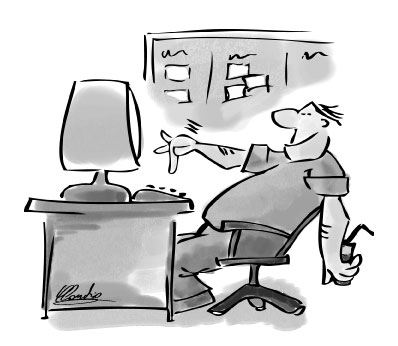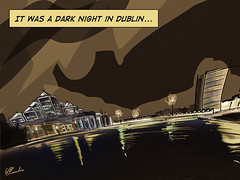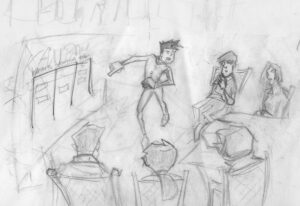It’s a matter of time. Time I don’t have.
I once learned that Alfred Hitchcock used to sketch on storyboards to pre-visualize the shots of his movies. What if I could apply cartooning and storyboarding techniques for my Zen-style presentations? With acceptable results, I thought, I could use those sketches as first-class citizens and incorporate them in my slides. Can you imagine the possibilities? No more frenetic searches for decent stock images, guaranteed originality and unlimited possibilities for further improvement.
This is one of the super crazy “what if” scenarios that I played in my head for quite some time but never had the courage to try – until recently.
Ladies and gents, I’m proud to unveil the making-of The Rise of the Lean Machine, a presentation that I just premiered at the excellent Lean & Kanban 2010 conference in Antwerp.
As many of you know, I’ve been obsessed about visual storytelling for many years. I developed a pretty good process to structure a story-driven presentation, borrowing techniques from screenwriting and creative nonfiction. As my Crafting Outstanding Presentations illustrates, Story, above everything else, is the main device that I use to render dry information memorable.
With all that focus on the power of Story, however, I never anticipated I could take my script further and create the kind of artwork you saw above, particularly at the crazy fast pace I had to deliver it. Heck, even my mum was as surprised as I was.
 It all started a couple of years ago when I decided to pick up a new hobby: drawing cartoons. Inspired and guided by Robin Hall’s excellent “The Cartoonist Workbook”, I soon learned how to turn my scribbles into something believable. I even bought myself a beautiful (and expensive) Wacom Cintiq 12WX to draw and color directly on screen. I can safely say that I could easily match the artwork that you see in typical cartoon strips in newspapers. You need tons of wit to succeed in that business, but that wasn’t my goal. Creating cartoons was relaxing, fun and… easy! So easy, in fact, that I’m almost certain that anyone can do it. All you need is that book, practice and simple observation.
It all started a couple of years ago when I decided to pick up a new hobby: drawing cartoons. Inspired and guided by Robin Hall’s excellent “The Cartoonist Workbook”, I soon learned how to turn my scribbles into something believable. I even bought myself a beautiful (and expensive) Wacom Cintiq 12WX to draw and color directly on screen. I can safely say that I could easily match the artwork that you see in typical cartoon strips in newspapers. You need tons of wit to succeed in that business, but that wasn’t my goal. Creating cartoons was relaxing, fun and… easy! So easy, in fact, that I’m almost certain that anyone can do it. All you need is that book, practice and simple observation.
But it wasn’t until I picked “Visualizing Ideas” and “The Storyboard Design Course” that I began to think that I could eventually apply those techniques for my presentations. I was daydreaming, however. Personal and professional events – some with catastrophic consequences – forced me to re-assess my priorities. My beloved cintiq quickly started to collect dust.
Fast forward to recent times.
I committed to present the Rise of the Lean Machine at the conference in Belgium because I had a genuinely good story to tell – a story that deserved to be told right. But all I had were vivid episodes which I captured by instinctively filling my whiteboard with post-its covered with scribbles rather than words. Could I translate them into comic art? It was a nice thought, but could I finish on time for the conference? Time was tight, so I run a quick feasibility experiment.
 Embarrassingly, it took me almost 2 days to complete the first drawing. Using a photo as loose reference, I sketched “It was a dark night in Dublin” on my tablet and painstakingly colored it. At school I did quite a bit of technical drawings, so I have no problem designing inanimate objects in perspective. But this time I wanted to add strong cinematic drama: bend the horizon, exaggerate the perspective, curve the buildings, choose a dark palette, hint at details with few color strokes. It was a completely new style for me altogether.
Embarrassingly, it took me almost 2 days to complete the first drawing. Using a photo as loose reference, I sketched “It was a dark night in Dublin” on my tablet and painstakingly colored it. At school I did quite a bit of technical drawings, so I have no problem designing inanimate objects in perspective. But this time I wanted to add strong cinematic drama: bend the horizon, exaggerate the perspective, curve the buildings, choose a dark palette, hint at details with few color strokes. It was a completely new style for me altogether.
I published that first picture on my flickr account for my own inspiration. I remember telling my wife, Irene: “I love it, but there is no way I can do 70 slides like that, there is just not enough time”. “Can you do only the key frames?,” she replied. “I don’t know. On the narrative side, I still need to work out the essential plot of the story”.
I didn’t know what to do and I was really worried. I posed a worthy challenge, but I was simply running out of time. My rational brain knew I couldn’t do it, my heart was telling I had to. You could cut the tension with a knife.
Our baby Matteo was born last year. We never had a break since. It might appear irrational, but despite the time bomb I was sitting on, we decided to put family first and go on a last-minute holiday break. Three weeks before the conference, I still had to tighten the structure of the story – something I knew I could do in a sunny Spanish island. As for the pictures, I just gave up on the whole idea of drawing them.
Well… I almost gave up. Surrounded by Mediterranean pine trees facing a beautiful sandy beach, I started sketching images on a plain notepad. I sketched for 2-3 hours a day using a simple pencil, a sharpener and an eraser. Damn, I needed a ruler too! At the end of the week, I had quite a bit of work done – enough to let me believe that, perhaps, I could actually pull it off.
Surrounded by Mediterranean pine trees facing a beautiful sandy beach, I started sketching images on a plain notepad. I sketched for 2-3 hours a day using a simple pencil, a sharpener and an eraser. Damn, I needed a ruler too! At the end of the week, I had quite a bit of work done – enough to let me believe that, perhaps, I could actually pull it off.
On my return at home I scanned each image and imported it on a 1600x1200px canvas in ArtRage Studio Pro. Then, using my tablet, I traced all the edges with a (virtual) ink pen. I don’t have a defined technique for coloring, but I generally color-block shapes first and then add light and shadows. I just pick one or more sources of light and give depth to shapes by coloring over the existing texture.
Frankly, my technique is instinctive and I’m only at the beginning of this journey.
As I always do when I’m under pressure, I set up a personal Kanban board with a simple TO DO, DOING(1), DONE workflow and 48 minutes timeboxes (12 minutes break) to work non-stop all day long. I honestly didn’t think I was going to finish on time, so I reduced the scope as I went along. I kept thinking about the conference, saying to myself “it’s only an hour, it’s only an hour”. I tweaked the story and slides until the last minute. There are a few slides with bullet points that I would like to rework, some images I would like to include, some sentences that I would like to clean up, some concepts I would like to further highlight (e.g. the role of Lean Enterprise Architecture). But hey, I had to constantly remind myself that there is a difference between being a perfectionist and an achiever.
The presentation has been an instant success. I received a lot of praise for the content, the story and the artwork. I paid a huge price too, however. Beside the sleepless nights during those frenetic 2 weeks, I had to decline working on a sizable business opportunity with an unmovable first deadline. That, my friends, hurt.
Was all this worth it? I don’t know.
But time, for sure, will tell.
Tick… Tock… Tick… Tock…

Great story, Claudio! Love it! I also used some ‘presentation zen’ techniques for my ‘ALM, TFS & Agile’ talks, had some nice response on them.
A few months ago I considered following a cartoon drawing course, but time constraints got in the way. I defenitely will pick up that book you mentioned.
Again, great presentation! Keep it going! Waiting on Maarten for posting the recording of your talk.
Grtz,
Enrico
Thank you Enrico! Ah, it’s a pity you couldn’t do the course, but I’m positive that the book will help immensely.
Hopefully the recording won’t disappoint you 🙂
Claudio,
You are brilliant. Since, you showed me your sketches, I listened to your talk and you introduced to me beyond bullet points, I do know what I need to improve. Also, I can’t believe that you have a so wide view about the full story: stream mapping, pce, EA, business canvas, etc.
Congratulations to be so creative, You are inspiring me.
Franck.
Pingback: ITK Podcast #4 : Interview with Claudio Perrone - itkanban - itkanban
Hi Claudio,
excellent presentation. You should check out the presentation software Prezi (prezi.com) as an alternative to powerpoint. It is a flow based presentation and your style of story telling would be perfect for it. I’m not affiliated in anyway but I do use it on occasion when I get bored of slides.
Also very interesting discussion on A3 thinking in the podcast – we are going through many of the pains you described.
Thanks conor. Yes I’m pretty familiar with prezi. I used it internally a couple of times, but to be honest I didn’t feel it was solving any problem for me and grew old pretty quickly. But I’m happy to see that it serves you well.